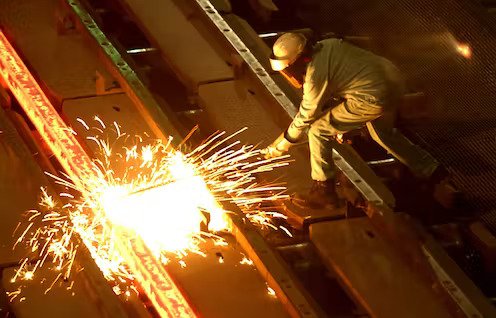European steel prices are expected to climb as protectionist policies and decarbonization efforts reshape the market, according to Bank of America (BofA) strategists. A potential demand rebound by 2025 could bring relief to European steel mills, which have struggled with weak demand, high energy costs, and cheaper imports.
The European Central Bank's rate cuts may help stabilize steel-intensive industries like construction and automotive, which saw steel consumption drop by 1.5% and 6% year-over-year. While BofA forecasts economic growth below 1%, restocking efforts could support price stabilization. However, structural challenges persist, with European steel producers urging trade protection through the European Steel Action Plan. This includes trade defense measures, a revised Carbon Border Adjustment Mechanism (CBAM), and incentives for clean energy adoption.
Trade regulations in the European Union (EU) are under review, potentially leading to a 20% cut in import quotas and increased tariffs. EUROFER has proposed raising steel import duties from 25% to between 32-41% to counter cheaper imports, particularly from China, where hot-rolled coil and galvanized steel prices have remained significantly lower than European levels.
Decarbonization remains a key challenge, with rising carbon costs pressuring mills to adopt greener technologies. BofA estimates steel prices need to sustain above €800 per ton—up from the current €590—to justify green investments. For green steel to be competitive, carbon prices must reach €130 per ton by 2030, with €160 per ton needed to curb competition from high-carbon imports.
If trade barriers tighten and carbon pricing aligns with EU targets, European mills could regain pricing power. However, cost pressures and competition from low-cost producers will continue to challenge profitability in the evolving market.



 Union-Aligned Investors Question Amazon, Walmart and Alphabet on Trump Immigration Policies
Union-Aligned Investors Question Amazon, Walmart and Alphabet on Trump Immigration Policies  Asian Stocks Slide as AI Spending Fears and Global Central Bank Decisions Weigh on Markets
Asian Stocks Slide as AI Spending Fears and Global Central Bank Decisions Weigh on Markets  Zelenskiy Urges Allies to Use Frozen Russian Assets as EU Summit Nears
Zelenskiy Urges Allies to Use Frozen Russian Assets as EU Summit Nears  Asian Stocks Slide as AI Valuation Fears and BOJ Uncertainty Weigh on Markets
Asian Stocks Slide as AI Valuation Fears and BOJ Uncertainty Weigh on Markets  Wall Street Futures Slip as Tech Stocks Struggle Ahead of Key US Economic Data
Wall Street Futures Slip as Tech Stocks Struggle Ahead of Key US Economic Data  New Zealand Budget Outlook Shows Prolonged Deficits Despite Economic Recovery Hopes
New Zealand Budget Outlook Shows Prolonged Deficits Despite Economic Recovery Hopes  U.S. Dollar Slips Near Two-Month Low as Markets Await Key Jobs Data and Central Bank Decisions
U.S. Dollar Slips Near Two-Month Low as Markets Await Key Jobs Data and Central Bank Decisions  U.S. Stock Futures Edge Higher as Micron Earnings Boost AI Sentiment Ahead of CPI Data
U.S. Stock Futures Edge Higher as Micron Earnings Boost AI Sentiment Ahead of CPI Data  Korea Zinc to Build $7.4 Billion Critical Minerals Refinery in Tennessee With U.S. Government Backing
Korea Zinc to Build $7.4 Billion Critical Minerals Refinery in Tennessee With U.S. Government Backing  Federal Appeals Court Allows Trump’s National Guard Deployment in Washington, D.C. to Continue
Federal Appeals Court Allows Trump’s National Guard Deployment in Washington, D.C. to Continue  U.S. House Advances GOP Healthcare Bill as ACA Subsidies Near Expiration
U.S. House Advances GOP Healthcare Bill as ACA Subsidies Near Expiration  Jared Isaacman Confirmed as NASA Administrator, Becomes 15th Leader of U.S. Space Agency
Jared Isaacman Confirmed as NASA Administrator, Becomes 15th Leader of U.S. Space Agency  Pakistan’s Army Chief Faces Gaza Troop Dilemma Amid US Pressure
Pakistan’s Army Chief Faces Gaza Troop Dilemma Amid US Pressure  Singapore Growth Outlook Brightens for 2025 as Economists Flag AI and Geopolitical Risks
Singapore Growth Outlook Brightens for 2025 as Economists Flag AI and Geopolitical Risks  Trump Administration Moves to Keep TransAlta Coal Plant Running Amid Rising AI Power Demand
Trump Administration Moves to Keep TransAlta Coal Plant Running Amid Rising AI Power Demand  Asian Stocks Edge Higher as Tech Recovers, U.S. Economic Uncertainty Caps Gains
Asian Stocks Edge Higher as Tech Recovers, U.S. Economic Uncertainty Caps Gains 































